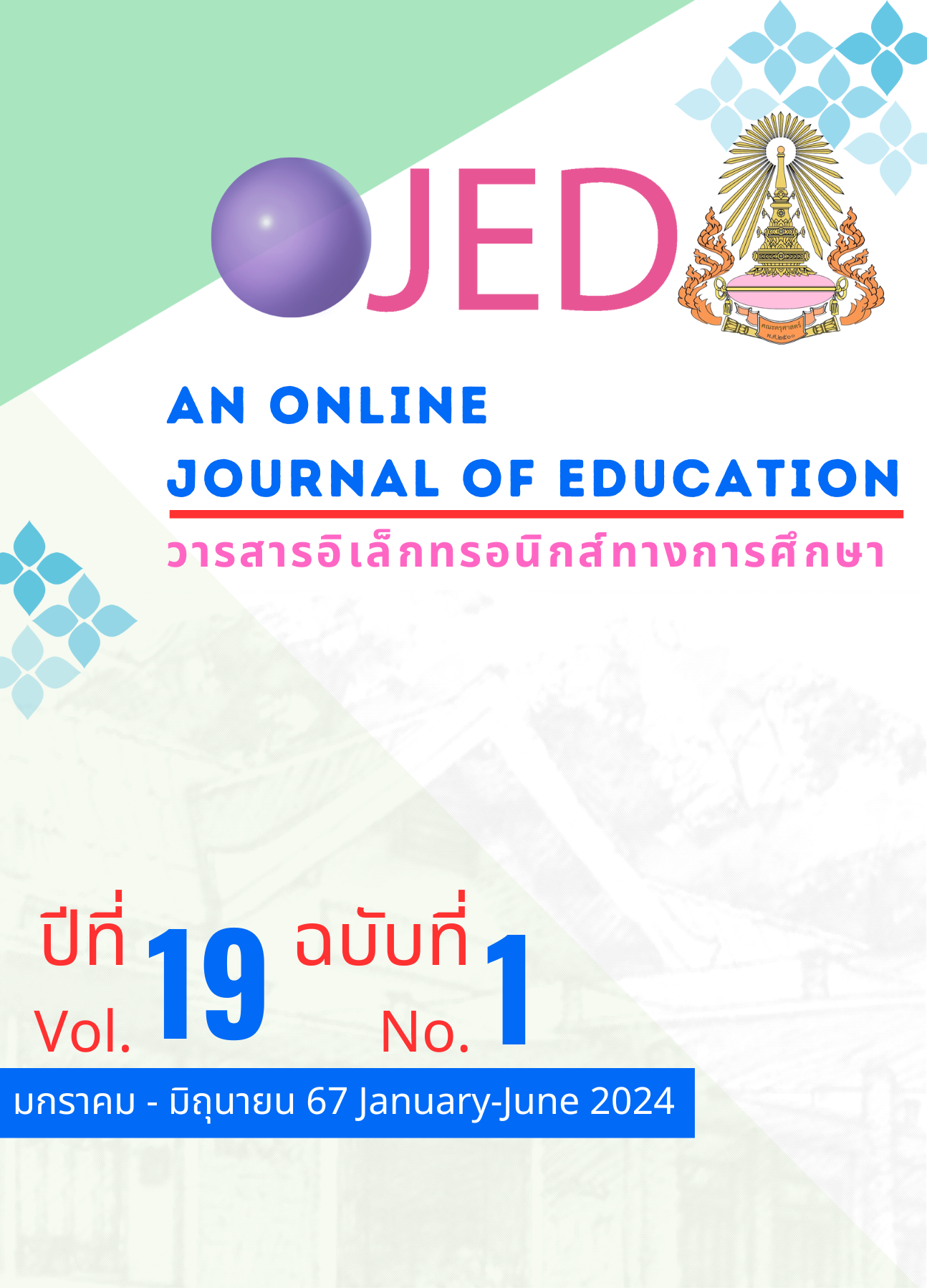Instructional Guidelines for Promoting Innovative Thinking of Secondary School Student
DOI:
https://doi.org/10.14456/ojed.2024.14Keywords:
Innovative Thinking Instruction, Innovative ThinkingAbstract
This research aims to 1) investigate instructional strategies for promoting innovative thinking among secondary school students 2) present instructional guidelines for promote innovative thinking among secondary school students. The sample consisted of 219 Thai teachers from secondary schools under the supervision of Bangkok Secondary Educational Service Areas Office 1. Research instruments included questionnaires and interviews. Collected data were analyzed using percentages, arithmetic average. and standard deviation. The results showed that: 1) Conditions for promoting innovative thinking among secondary school students are 1.1) teachers being able to set objectives for students so that they can learn about and understand innovation, leading to the students being able to generate ideas and results from their own ideas; 1.2) teachers allowing students to obtain new ideas; 1.3) teachers incorporating technological media to help organize teaching and learning; and 1.4) teachers measuring and evaluating students based on their ability to engage in and carry out the process of innovation. 2) Guidelines for promoting innovative thinking among secondary school students: 2.1) teachers should be able to set objectives with a focus on providing students with knowledge, understanding, and the capability to perform the work according to the process in an ethical manner; 2.2) teachers selecting teaching methods that are continually revised according to the innovation process while providing opportunities for students to practice on their own; 2.3) choosing media that can connect ideas to create a feasible process for developing innovations; and 2.4) periodically evaluating students’ ability to generate ideas and efficiently transform them into innovative results under real-life conditions.
References
ภาษาไทย
ทิศนา แขมมณี. (2546). ศาสตร์การสอน: องค์ความรู้เพื่อการจัดกระบวนการเรียนรู้ที่มีประสิทธิภาพ. พิมพ์ครั้งที่ 17. กรุงเทพฯ: จุฬาลงกรณ์มหาวิทยาลัย.
สำนักงานคณะกรรมการส่งเสริมวิทยาศาสตร์วิจัยและนวัตกรรม. แผนกลยุทธ์สำนักงานคณะกรรมการส่งเสริม วิทยาศาสตร์วิจัยและ นวัตกรรม (สกสว.) พ.ศ. 2564 – 2566 (ฉบับทบทวน 2565). สืบค้นจาก https://d.tsri.or.th/klE6do4J4p
ภาษาอังกฤษ
Cropley, D. H., Kaufman, J. C., & Cropley, A. J. (2011). Measuring Creativity for Innovation Management. Journal of Technology Management & Innovation, 6(3), 13–30. Retrieved from https://doi.org/10.4067/S0718-27242011000300002
Drapeau, P. (2014). Sparking Student Creativity. Practical Ways to Promote Innovative Thinking and Problem Solving. North Garden, VA ASCD.
Kite, V., & Park, S. (2020, March). Secondary science teachers’ conceptualizations of computational thinking and perceived barriers to CT/content integration. In Prepared for the 2020 annual meeting of the National Association for Research in Science Teaching and teacher education (NARST).
Markham, T. (2013). 10 Ways to teach innovation. Retrieved from https://ww2.kqed.org /mindshift/ 2013/04/01/10-ways-to-teach-innovation/
Morad, S., Ragonis, N., & Barak, M. (2021a). An Integrative Conceptual Model of Innovation and Innovative Thinking Based on a Synthesis of a Literature Review. Thinking Skills and Creativity, 100824.
OA Acar, M Tarakci, D van Knippenberg. (2019) Creativity and Innovation Under Constraints: A Cross-Disciplinary Integrative Review. Journal of Management 45 (1), 96-121
Taro Yamane. (1970). Statistic: An Introductory Analysis (2nd ed.). New York: Harper & Row.
Xu, Z. (2010). Research and Practice on Basic Composition and Cultivation Pattern of College Students’ Innovative Ability. International Education Studies.
Zeng, L., Proctor, R. W., & Salvendy, G. (2011). Can traditional divergent thinking tests be trusted in measuring and predicting real-world creativity? Creativity Research Journal, 23(1), 4–37. Retrieved from https://doi.org/10.1080/10400419.2011.545713
Downloads
Published
How to Cite
Issue
Section
License
Copyright (c) 2024 An Online Journal of Education

This work is licensed under a Creative Commons Attribution-NonCommercial-NoDerivatives 4.0 International License.




